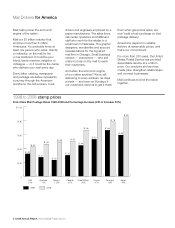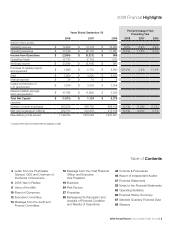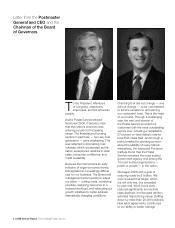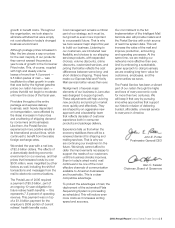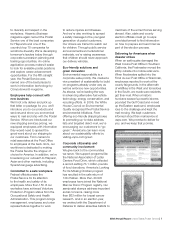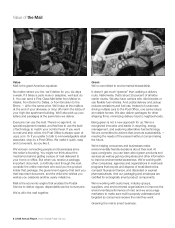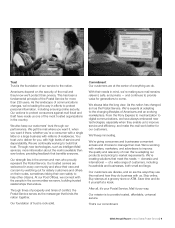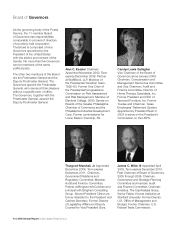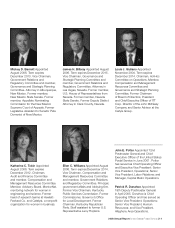US Postal Service 2008 Annual Report Download - page 5
Download and view the complete annual report
Please find page 5 of the 2008 US Postal Service annual report below. You can navigate through the pages in the report by either clicking on the pages listed below, or by using the keyword search tool below to find specific information within the annual report.
2008 Annual Report United States Postal Service | 5
growth in benefit costs. Throughout
the organization, we took steps to
eliminate activities that were simply
not cost effective in today’s changed
business environment.
Although postage prices increased in
May, the law places a cap on prices
for the vast majority of our products:
they cannot exceed the previous
year’s rate of growth in the Consumer
Price Index. This, of course, coupled
with high and steady volume
losses of more than 4.5 percent —
9.5 billion pieces of mail — was
insufficient to offset growth in costs
that was led by the highest gasoline
prices our nation has ever seen —
prices that did not begin to moderate
until near the close of the fiscal year.
Providers throughout the entire
package and express delivery
business, each heavily dependent
on transportation, were affected by
the steep increases in fuel prices
and a softening of shipping demand
by consumers and businesses.
Like them, the Postal Service
experienced more positive results in
its international product lines, which
continued to benefit from favorable
foreign exchange rates.
We ended the year with a net loss
of $2.8 billion dollars. The effects of
a dramatically declining economic
environment on our revenue, and fuel
prices that increased costs by over
$500 million, were magnified by other
factors as well, including the shift of
transactions and messages from the
mail to electronic communications.
The Postal Law of 2006 required
a payment of $5.6 billion, part of
an ongoing 10-year obligation for
future retiree health benefits — this
represents 7.5 percent of operating
revenue. This payment was on top
of a $1.8 billion payment for the
employer’s 2008 portion of current
retirees’ health benefits costs.
Cost management remains a critical
part of our strategy, as it must be,
but growth is even more important
to a successful future. That is why
we took several major steps this year
to build our business. Listening to
our customers, we introduced new
flexibility and choices to our shipping
services products, with expanded
choices, volume discounts, online
discounts, customized services, and
pricing that better reflects the cost
differences between some long- and
short-distance shipping. These have
made our Express Mail and Priority
Mail services better values than ever.
Realignment of several major
elements of our business in June also
was designed to support growth.
These adjustments will help us bring
new products and pricing to market
more quickly and effectively. They
are shaped by an aggressive new
approach and a leadership team
that reflects decades of customer
experience both in consumer
products and package delivery.
Experience tells us that when the
economy stabilizes there will be a
renewed demand for shipping and
mailing services. That is why we
are continuing our investment in the
future. We simply cannot afford to
defer the improvements necessary to
support the needs of our customers
until the business climate improves.
Even in today’s wired world, mail
continues to be one of the most
effective channels of communication
available to American businesses
and households. This is a clear
competitive advantage.
To protect the advantages of mail, the
deployment of the automated Flats
Sequencing System is proceeding
as scheduled. This will reduce even
more costs as it increases sorting
speed and accuracy.
Our commitment to the full
implementation of the Intelligent Mail
barcode also will provide mailers and
the Postal Service with a rich source
of real-time system data. This will
increase the value of the mail and
improve production, accounting,
and operating processes. At the
same time, we are making our
networks more effective than ever.
And by embracing a sustainable,
green approach to doing business,
we are creating long-term value for
customers, employees, and the
communities we serve.
The Postal Service has been a vibrant
part of our nation through the highs
and lows of every economic cycle
for more than two centuries. We
will keep it that way by pursuing
innovative approaches that support
our historic mission of delivering
trusted, affordable, universal service
to everyone in America.
John E. Potter
Postmaster General/CEO
Alan C. Kessler
Chairman, Board of Governors


